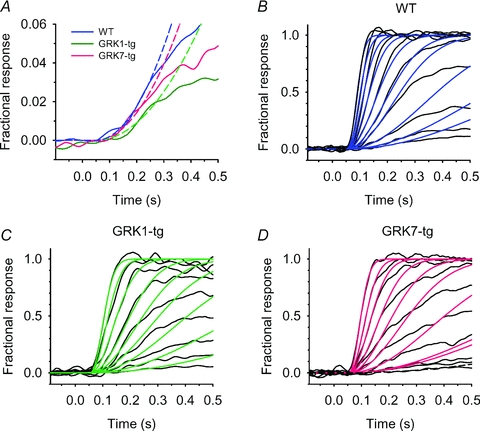Figure 8. Estimation of the amplification constant (A) for representative rods of the three genotypes, from single-photon responses (A) and from families of flash responses (B–D).

A, onset phase of single-photon response, avar(t), for a representative rod from WT (blue), GRK1-tg (red), and GRK7-tg (green) zebrafish. The parabolas (broken lines) plot the fitted predictions of eqn (6), giving A = 1.5, 0.8, and 1.2 s−2 respectively. The effective delay time was constrained to teff= 48 ms for each cell, according to the fitting for bright flash responses. For the flash intensities used, these single-photon responses yielded ‘functional’ effective collecting areas of Ac= 1.99, 1.8 and 0.28 μm2 for the three cells. B–D, families of flash responses (black lines) for the three rods in A, fitted with the predictions of the Lamb & Pugh model including capacitive time constant (coloured lines; using eqn (5) of Smith & Lamb (1997); the end time for the calculation of fit was varied from 130 ms for bright-flash responses to 250 ms for dim-flash responses. In order to provide an appropriate fit to the responses to brighter flashes, the capacitive time constant was set to 5 ms, and the residual delay of the remaining stages was set to 43 ms, giving a total effective delay time of teff= 48 ms (used above in A). The numbers of isomerizations were determined by extrapolation from the intensities that elicited a single photoisomerization according to the avar analysis (which we used above to extract the functional effective collecting area). B, WT rod. Flashes delivered from 1.8–900 photoisomerizations for the collecting area of 1.99 μm2; fitted amplification constant A = 1.8 s−2. C, GRK1-tg rod. Flashes delivered from 1.7–442 photoisomerizations for the collecting area of 1.8 μm2; fitted amplification constant A = 1.0 s−2. D, GRK7-tg rod. Flashes delivered from 1.2–252 photoisomerizations for the collecting area of 0.28 μm2; fitted amplification constant A = 1.4 s−2.
